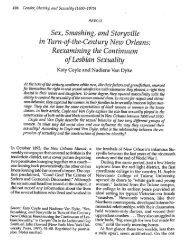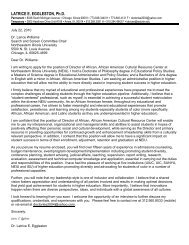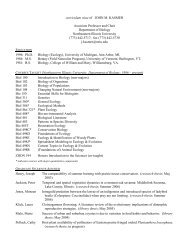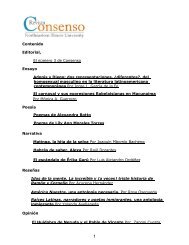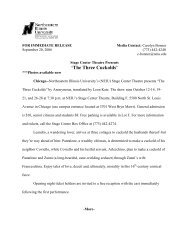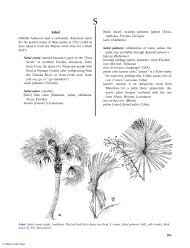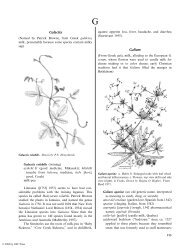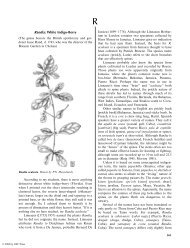Herba Cana - Northeastern Illinois University
Herba Cana - Northeastern Illinois University
Herba Cana - Northeastern Illinois University
Create successful ePaper yourself
Turn your PDF publications into a flip-book with our unique Google optimized e-Paper software.
© 2004 by CRC Press<br />
The Ethnobotany 553<br />
who recall the old medicines still note similar uses<br />
(Snow and Stans 2001).<br />
Chemical studies of several Pterocaulon species<br />
show that the plants contain a variety of coumarins<br />
(Debenedetti et al. 1981, 1991, 1992, 1994, 1996. 1997,<br />
1998, 1999, Magalhaes et al. 1981, 1989, Boeykens et<br />
al. 1994, Vilegas et al. 1995, MacLeod and Rasmussen<br />
1999, Palacios 1999, Vera et al. 2001). Coumarins have<br />
a long history of use as a blood anticoagulant (Lewis<br />
and Elvin-Lewis 1977). Coumarins are lactones, which<br />
are vitamin K antagonists, and they act as indirect<br />
anticoagulants with a delayed effect. Following oral<br />
ingestion, absorption, and metabolism in the liver,<br />
chemical action results from a reduction in synthesis<br />
of prothrombin, a plasma protein produced in the liver<br />
in the presence of vitamin K. Prothrombin is converted<br />
into thrombin during the clotting of blood.<br />
Alterations of these pathways change the ability of<br />
blood to clot, and noticing this change is surely partly<br />
what led people to use these plants. Clotting alteration<br />
would have been the obvious result when people used<br />
Pterocaulon as abortives and styptics, and to relieve<br />
menstrual difficulties (Sturtevant 1955, Uphof 1968,<br />
Morton 1974).<br />
Coumarins and their derivatives are not the only<br />
bioactive chemicals in Pterocaulon. Other studies show<br />
that the plants contain caffeolyquinic acids (Martino<br />
et al. 1979), thiophene acetylenes and flavonols (Bohlmann<br />
et al. 1981), flavonoids (Semple et al. 1998,<br />
1999), flavanones, and caryophyllene (MacLeod and<br />
Rasmussen 1999). These chemicals are antioxidant,<br />
prooxidant (Desmarchelier et al. 1997), and antiviral<br />
(Semple et al. 1998, 1999). Thus, the mixture of<br />
chemicals extracted into medicines made from Pterocaulon<br />
would be effective against colds and asthma.<br />
Sturtevant (1955) also recorded the Creek name<br />
for these plants, and Snow and Stans (2001) confirm<br />
that it is still used. In Creek, the plants are yvnvsv<br />
heleswv [yanasa hiliswâ] (yvnvsv, buffalo, heleswv,<br />
medicine). The allusion to a buffalo may seem odd<br />
in the modern world largely devoid of them. However,<br />
Bison bison historically ranged into the woodlands of<br />
the eastern United States well within the area occupied<br />
by the Creeks and ancestors of the Miccosukees (cf.<br />
Caras 1967).<br />
The Seminoles also sometimes used blackroot in<br />
the busk (Capron 1953), a term derived from their<br />
word posketv [poskita] (to fast, Creek). The busk, or<br />
Green Corn Ceremony, involves a 4-day festival,<br />
sometimes with 1 to 3 preliminary days added. The<br />
event occurs between late April and mid-July. Special<br />
busk grounds are prepared distant from both Seminole<br />
and white settlements. During the evening of the<br />
third day, fires are rekindled with flint and steel in the<br />
old manner, and the sacred medicine bundle is opened.<br />
The contents of the medicine bundle are usually kept<br />
secret, but at least three outsiders in recent history<br />
have been permitted to examine it. Spoehr (1939),<br />
Capron (1953), and Sturtevant (1954) were each<br />
permitted to make notes on the contents of different<br />
medicine bundles. Each of the three found similarities<br />
and differences in the contents. Capron (1953) is the<br />
only one who found Pterocaulon in the bundle.<br />
Regardless of the exact contents of the medicine<br />
bundle, a variety of its plant contents (up to 20 plants)<br />
was used to brew the ayikctanahki (gathered medicine)<br />
or ayikctanahkco:bi (big gathered medicine), a critical<br />
beverage in the cleansing of the old year and preparation<br />
for the new.<br />
The only other record of use of Pterocaulon found<br />
from Florida was by Murphee (1965). She was told<br />
that people in the Panhandle used it to cure ‘‘teen age<br />
trouble’’ (illegitimate pregnancy).<br />
The genus contains 18 species in the warm parts of<br />
the Americas and southeastern Asia, reaching to<br />
Australia and New Caledonia (Cabrera and Ragonese<br />
1978). Within its range, medicines are known to be<br />
made from it in the United States, Argentina (Vera et<br />
al. 2001), Brazil (Magalhaes et al. 1989), and Australia<br />
(Cribb and Cribb 1981, Semple et al. 1998, MacLeod<br />
and Rasmussen 1999). Perhaps not surprisingly, the<br />
aborigines of Australia also use the leaves as a tobacco<br />
substitute (Cribb and Cribb 1981). Nothing has been<br />
found to corroborate the inference, but maybe that is<br />
why Uphof (1968) said blackroot was a ‘‘stimulant’’<br />
and Morton (1974) simply wrote that it was ‘‘narcotic.’’<br />
Nothing about its chemistry suggests those<br />
impacts on users.<br />
Possibly the leaves are poor substitutes for Nicotiana.<br />
That might be why it was called ‘‘rabbit’’ tobacco.<br />
Either way, the common name conjures up the image<br />
of some pensive rabbit sitting on its haunches puffing<br />
on a pipe.<br />
Pycnanthemum<br />
(André Michaux created this name with Greek pycnos,<br />
dense, and anthemon, a flower, from the compact<br />
inflorescences)<br />
[American wild] basil (comparing the fragrance to<br />
the cultivated basil, Ocimum basilicum)<br />
Dickblume (dense flowers, German)<br />
mountain-mint (William Salmon included ‘‘mountain-mint’’<br />
in 1671 in his Synopsis Medicina for<br />
what is now Clinopodium, with about 20<br />
European species; the name later was shifted to<br />
the New World, and ‘‘mountain-mint’’ used for<br />
Pycnanthemum by 1861)





